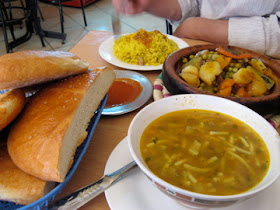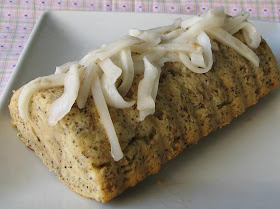| No way you can stop at just a small handful of these... Come on, I dare you |
I would even avoid making everyday dishes to eat with rice such as oyster sauce beef, chicken curry or sautéed cabbage. Since you could get them anywhere, I would make less available dishes at home, like pastas, hearty soups and gourmet sandwiches – mostly Western-type food that I knew I could make better than any chain restaurant.
I think, in a way, I didn't feel confident cooking Malaysian. If I couldn't get my fish curry to taste like my mother's or the dish at a good restaurant, then why bother, I told myself. That's changed in the last few months. Since writing this blog as well as the Don't Call Me Chef column (see tab above), I've come to know local food more intimately, and now we have a better relationship. I don't simply consume and fulfil my own need, I genuinely want to find out what the dish goes through as well.
Carol Selva Rajah's new cookbook, Malaysian Cooking: A Master Cook Reveals Her Best Recipes (here's the link to my review in The Star, "Scents to savour") is one of those books that have helped me realise there's no need to fret over making local everyday dishes. A lot of cookbooks are written by celebrity chefs and have beautiful pictures – Selva Rajah's book, published by Tuttle Publishing with photography by Masano Kawana, is no different. Not every writer, however, gives instructions and recipes that are easy to follow and, more importantly, work. In this regard, Malaysian Cooking is a joy to read and cook from.
Just as I got better at cooking foreign food and making bread by reading up what master cooks have written about it, I'm confident cooking local food will also come naturally in time, even if I never become a master myself. And a book like Malaysian Cooking helps tremendously.
Here are more recipes from the book.
* * *
As I said in the post before this one, this ikan bilis snack (pictured above) is absolutely moreish. Instead of chilli powder, I used smoked paprika. Use the smaller variety of peanuts instead of the large ones I have used here. (Yes, I know, they're a little burnt!)
SWEET AND SPICY FISH NIBBLES WITH PEANUTS
Serves 4-6250g (2 cups) dried baby anchovies (ikan bilis) or whitebait, heads and veins removed, rinsed and drained
2 teaspoons rice flour, for dusting
1½ cups (375ml) oil for shallow-frying
1-2 teaspoons ground red pepper (chilli powder), or to taste
1 teaspoon thick sweet soy sauce (kecap manis)
200g (1 cup) dry-roasted unsalted peanuts
Sugar Syrup
50g (¼ cup) sugar
¼ cup (60ml) water
- Dust the dried anchovies with the rice flour. heat the oil in a wok until very hot – it is ready when bubbles form around a skewer dipped in it. Fry the anchovies over medium heat until golden brown and crispy, about 1 minute. Remove them from the oil and drain on paper towels.
- Make the sugar syrup by combining the sugar and water in a small saucepan over medium heat, stirring until the sugar dissolves. Allow it to boil and simmer for about 1 minute to thicken the syrup slightly. Remove the syrup from the heat, pour it into a clean wok and heat over medium heat. When the sugar syrup bubbles, add the fried anchovies, ground red pepper and sweet thick soy sauce, and toss well to coat the anchovies with the syrup. Stir in the peanuts and remove from the heat.
* * *
Carol Selva Rajah writes that this is a quick and easy curry to make, and it is. I'm not keen on canned sardines but the gravy was delicious. In the future, I'll make this with fresh fish and add crushed tomato and tomato paste.
| Tinned sardines are a store-cupboard staple in many homes, which makes this a quick dish to prepare for unexpected guests, Selva Rajah says |
TOMATO AND TAMARIND FISH CURRY
2 tablespoons oil
¼ teaspoon fenugreek seeds
5 cloves garlic, chopped
1 onion, chopped
1 stalk curry leaves, plucked and chopped
1 green and 1 red finger-length chilli, halved and deseeded
3 ripe tomatoes, quartered
2 tablespoons tamarind pulp, mashed with 1 cup (250ml) hot water and strained to obtain juice
3 tablespoons fish curry powder
One 450g can sardines in tomato sauce
Salt, to taste
- Heat the oil in a saucepan and sauté the fenugreek seeds for a few seconds. Add the garlic, onion, curry leaves and chillies and sauté until golden and fragrant, about 2 minutes. Stir in the tomato and sauté for 1-2 more minutes.
- Pour in the tamarind juice and add the curry powder, then cover and bring to a boil. Reduce the heat to low and simmer for 10 minutes. Stir in the sardines and continue to simmer uncovered for 3 more minutes. Season with salt to taste and remove from the heat. Serve immediately.
* * *
MINT PACHADI CHUTNEY
Makes 1½ cups1 tablespoon oil
1 onion, chopped
2 cloves garlic, sliced
12mm fresh ginger, cut into thin shreds
4 green finger-length chillies, deseeded and sliced
2 tablespoons dried unsweetened grated (dessicated) coconut, dry-roasted until golden brown
80g (2 cups) fresh mint leaves, washed and dried
Freshly squeezed juice of 2 limes
Salt, to taste
- Heat the oil in a wok and stir-fry the onion, garlic and ginger over medium heat until golden and tender. Add the chilli and coconut and stir-fry for 1 minute, then remove from the heat. Process the coconut mixture with the mint leaves in a food processor until smooth. Transfer to a bowl and add the lime juice and salt to taste. Cover and chill until ready to serve. It keeps refrigerated for 3-4 days.
* * *
There wasn't enough space in the papers, so I omitted the recipe for green onion curls that are used to garnish the Ginger Soya Chicken with Rice Wine featured in the article. Here's how you do it: GREEN ONION CURLS
2-3 green onions
Bowl of iced water
- Trim off the bulb of each green onion at the point where the stem begins to turn green. Slice the leaves into 10cm lengths. Using a sharp knife, slice each length into thin strips lengthwise. Soak the strips in a bowl of iced water and refrigerate until they curl up.









